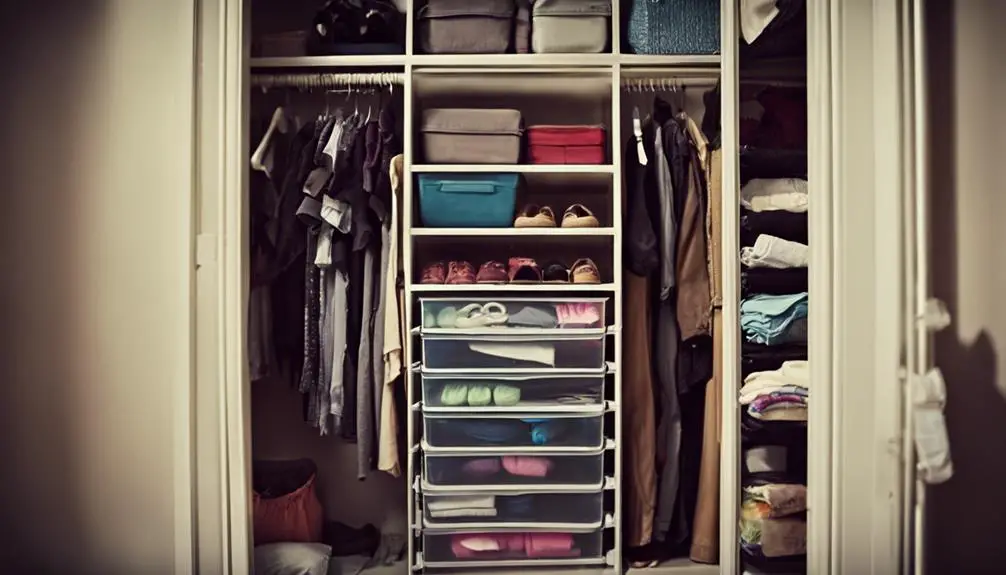Take a step into your closet – are you overwhelmed by clutter, struggling to find what you need, or simply tired of the chaos? You're not alone. The good news is that with a few clever hacks, you can transform your closet into a serene and functional space. By maximizing your closet's vertical storage, doubling your hanging capacity, and utilizing hidden shelves, you can create a haven that makes your daily routine easier. But that's just the beginning – and we're about to reveal the secrets to a truly organized closet.
Key Takeaways
- Utilize vertical space by installing shelves, storage units, or hanging rods to more than double storage room and store out-of-season items.
- Installing double hang rods instantly doubles the closet's hanging capacity, allowing for more garments in a smaller footprint.
- Incorporate hidden shelves with sliding panels or doors to conceal items like out-of-season clothing or luggage, maintaining a sleek, organized look.
- Repurpose old furniture as functional storage solutions in the closet, breathing new life into old pieces and reducing waste.
Maximize Vertical Storage Space
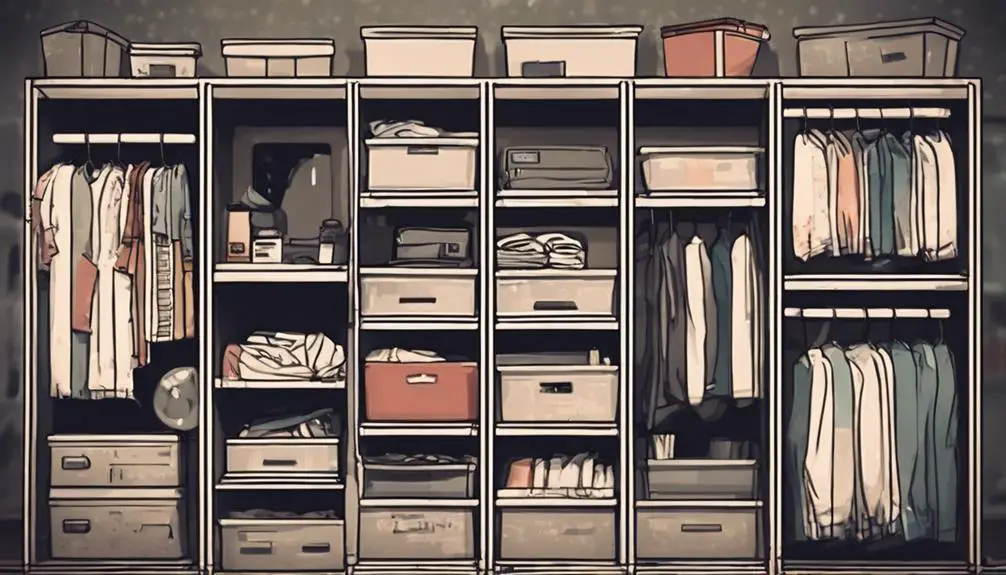
To maximize your closet's storage capacity, start by utilizing the often-wasted vertical space between the top shelf and the ceiling, where you can install shelves, storage units, or hanging rods to more than double your storage room.
This area is perfect for storing out-of-season clothing, luggage, or infrequently used items. Consider installing ceiling shelves, which can be custom-made to fit your closet's dimensions.
These shelves provide ample storage for bins, baskets, and containers, keeping your belongings organized and out of the way.
To guarantee the shelves are securely fastened, use vertical anchors that screw directly into the ceiling. These anchors provide a sturdy base for your shelves, preventing them from collapsing under the weight of your stored items.
By maximizing your closet's vertical space, you'll be able to store more items without sacrificing floor space. This will create a more organized, clutter-free closet that makes the most of its available space.
With a little creativity and some strategic planning, you can turn your closet into a highly functional and efficient storage area.
Double Hang Rods for Efficiency
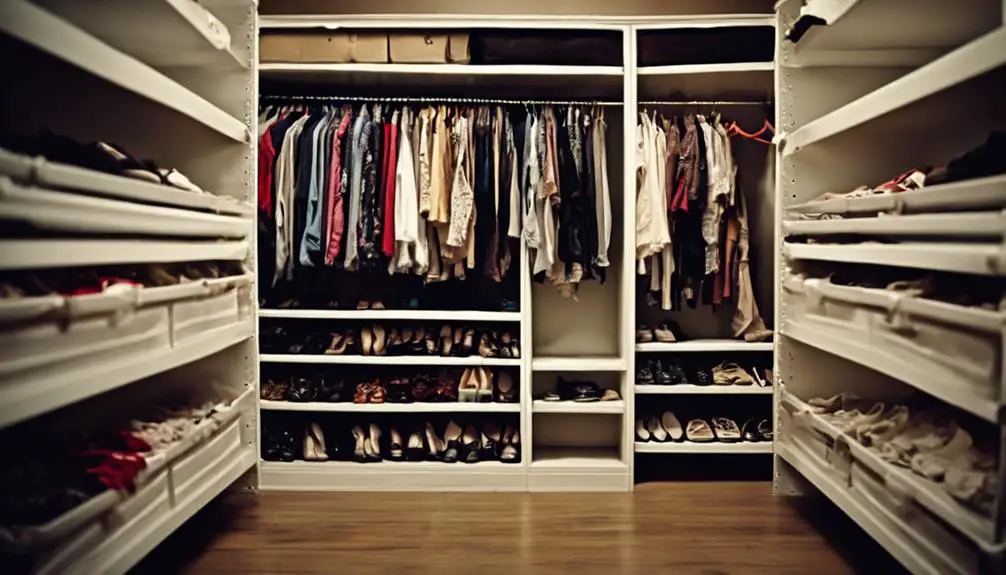
By installing double hang rods, you can instantly double your closet's hanging capacity, allowing you to store more garments in a smaller footprint.
This clever hack is perfect for those with limited closet space or an extensive wardrobe.
When it comes to rod placement, consider positioning the top rod at a comfortable height, around 60-70 inches from the floor, and the bottom rod about 40-50 inches from the floor.
This allows for easy access to your most frequently worn items while keeping out-of-season or less-used garments stored below.
When deciding on a hang style, you can choose from two options: parallel or staggered rods.
Parallel rods provide a sleek, streamlined look and are ideal for hanging similar types of garments, such as dresses or tops.
Staggered rods, on the other hand, offer more flexibility and can accommodate garments of varying lengths, making them perfect for hanging a mix of dresses, tops, and pants.
Whatever your preference, double hang rods are a game-changer for maximizing your closet's storage potential and keeping your wardrobe organized.
Utilize Hidden Shelves Effectively

How do you make the most of your closet's vertical space without sacrificing style or accessibility?
By incorporating hidden shelves, you can maximize storage while maintaining a sleek, organized look. Install shelves with sliding panels or doors to conceal items you don't need frequent access to, like out-of-season clothing or luggage.
These hidden compartments provide secret storage for valuable or sensitive items, keeping them out of sight but still within reach.
When planning your hidden shelves, consider the items you want to store and their size.
Designate shelves for specific categories, like accessories or linens, to keep your closet organized and easy to navigate. You can also add baskets, bins, or drawers to further compartmentalize your storage.
Don't forget to leave enough clearance between shelves for easy retrieval and to prevent clutter from building up.
With hidden shelves, you'll be amazed at how much more you can fit in your closet without sacrificing style or functionality.
Repurpose Old Furniture Creatively
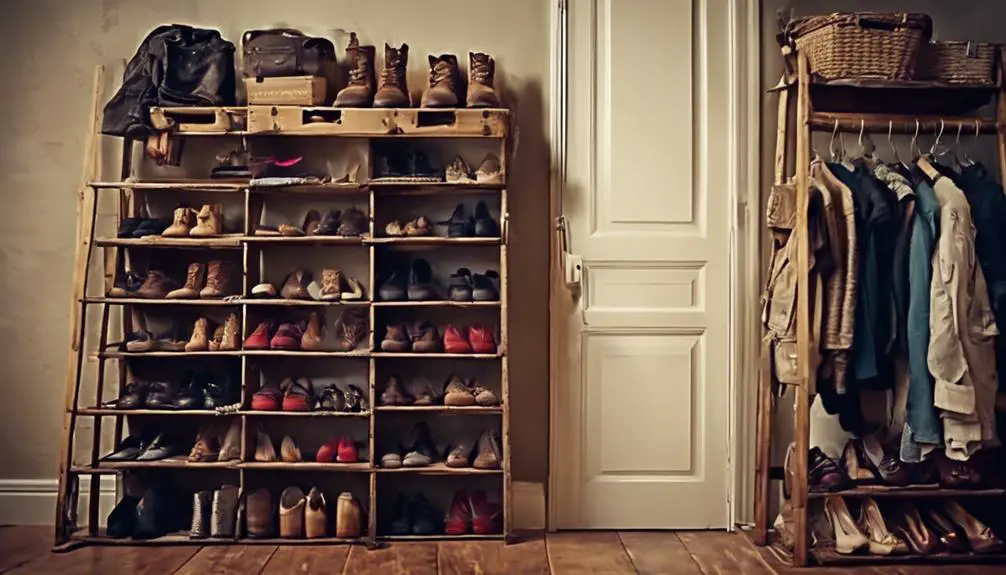
You can breathe new life into old furniture by repurposing it as functional storage solutions in your closet, giving you a chance to get creative and reduce waste.
Think beyond the original purpose of that old dresser or bookshelf and envision it as a unique storage unit. A furniture makeover can transform an outdated piece into a one-of-a-kind upcycled decor that adds character to your closet.
For instance, you can repurpose an old ladder as a shoe rack or turn a vintage window into a display case for your accessories.
Get creative with paint, hardware, and fabric to give your repurposed furniture a fresh new look that complements your closet's style.
By upcycling old furniture, you'll not only reduce waste but also create a functional and eco-friendly storage solution that reflects your personal style.
With a little imagination, you can turn discarded items into functional works of art that elevate your closet's organization and aesthetic.
Invest in Stackable Containers

To maximize your closet's vertical space and keep items neatly categorized, consider investing in a set of stackable containers that can be easily labeled and rearranged as your storage needs evolve.
These versatile containers come in various stackable styles, allowing you to customize your storage solution to fit your specific needs. You can use them to store everything from folded clothes and accessories to shoes and seasonal items.
When choosing your stackable containers, look for ones with removable container labels or chalkboard labels that can be easily updated as your storage needs change.
This will certify that you can quickly identify what's inside each container without having to dig through them. Additionally, consider stackable containers with different sizes and shapes to accommodate items of varying sizes.
Optimize Shelf Dividers Wisely

When optimizing shelf dividers, you'll want to start by categorizing your items and grouping similar types together.
This will help you assign shelf priority, ensuring that your most frequently used items are easily accessible.
Divide by Category Type
Categorizing similar items together is an effective way to maximize storage space and ease of access within your closet.
By dividing your belongings into category clusters, you can create a personalized grouping system that makes sense for your lifestyle. For instance, you can group all your tops together, followed by your bottoms, dresses, and outerwear.
Within each category, you can further sub-divide items by type, such as short-sleeve shirts, long-sleeve shirts, and tank tops.
When dividing by category type, consider the frequency of use and the seasonality of your items.
Store out-of-season clothing in labeled bins or containers to free up space for your current wardrobe. You can also designate specific shelves or areas for accessories, shoes, or bags.
By grouping similar items together, you'll be able to see what you have at a glance, making it easier to plan outfits and avoid clutter.
Remember to keep your most frequently worn items front and center, and store less-used items towards the back or on higher shelves.
With a well-organized category system, you'll be able to maintain your closet's organization and make the most of your space.
Assign Shelf Priority
Your shelves should be prioritized to reflect your most frequently worn and essential items, guaranteeing they're easily accessible and visible.
By doing so, you'll create a functional and efficient closet space.
To achieve this, categorize your items into three groups: daily wear, occasional wear, and special occasion wear.
Allocate your top shelves for items you use daily, such as work attire or favorite casual clothes. This shelf categorization will guarantee that your most-needed items are within easy reach.
Next, designate middle shelves for occasional wear, like special event outfits or seasonal clothing.
Finally, reserve lower shelves for special occasion wear, like formal wear or out-of-season items.
By optimizing your shelf allocation in this way, you'll create a logical and convenient storage system that saves you time and effort when getting dressed.
This thoughtful approach will also help you maintain a clutter-free closet and make the most of your available space.
Utilize Vertical Space
To maximize your closet's vertical space, you can strategically install shelf dividers that separate and classify your belongings, allowing you to make the most of every inch of storage.
This hack is especially useful for high shelves that are hard to reach, where you can store infrequently used items like out-of-season clothing or luggage.
To access these items, consider investing in a storage ladder that can be easily folded and stored away when not in use.
When installing shelf dividers, make sure to measure your closet's dimensions accurately to guarantee a snug fit.
You can also customize your dividers to fit your specific needs, such as adding labels or categories to keep similar items together.
Additionally, consider using stackable bins or baskets to store small items like accessories or socks, keeping them organized and easy to find.
Organize Accessories With Hooks
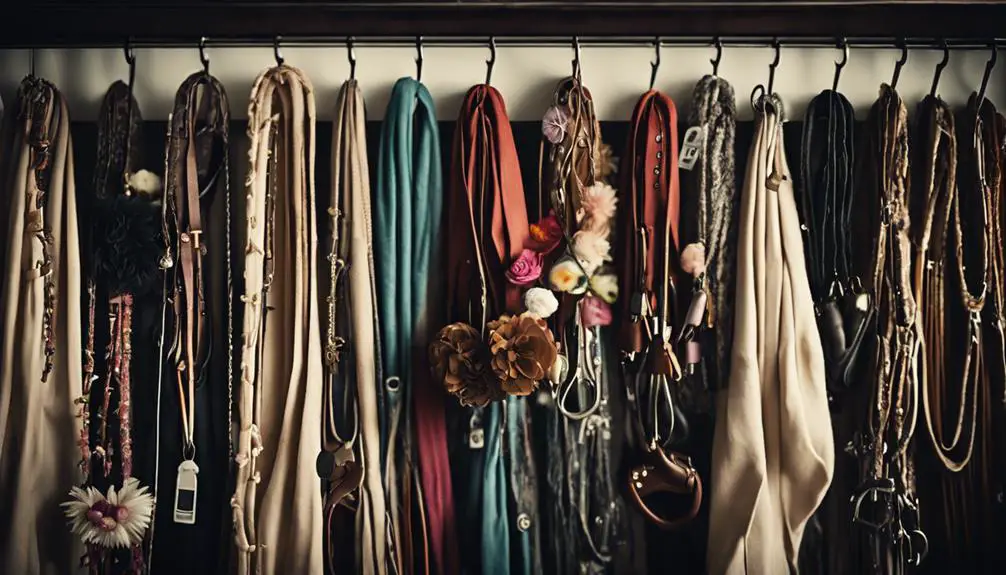
You can maximize your closet's storage potential by strategically placing hooks to hold accessories like hats, belts, and scarves.
This simple yet effective solution helps keep your closet floor and shelves clutter-free, making it easier to find what you need.
Install accessory hooks on the back of a door, on a wall, or even on the side of a shelf.
This will create a designated spot for your accessories, keeping them organized and within reach.
For your scarves, consider using scarf organizers with hooks.
These can be hung on the back of a door or on a wall, and they'll keep your scarves tidy and prevent them from getting tangled or wrinkled.
You can also use hooks with clips or small bins to store belts, hats, or bags.
By using hooks to organize your accessories, you'll be able to see everything at a glance, making your morning routine faster and more efficient.
Plus, you'll reduce clutter and create a sense of calm in your closet.
Create a Shoe Station Easily
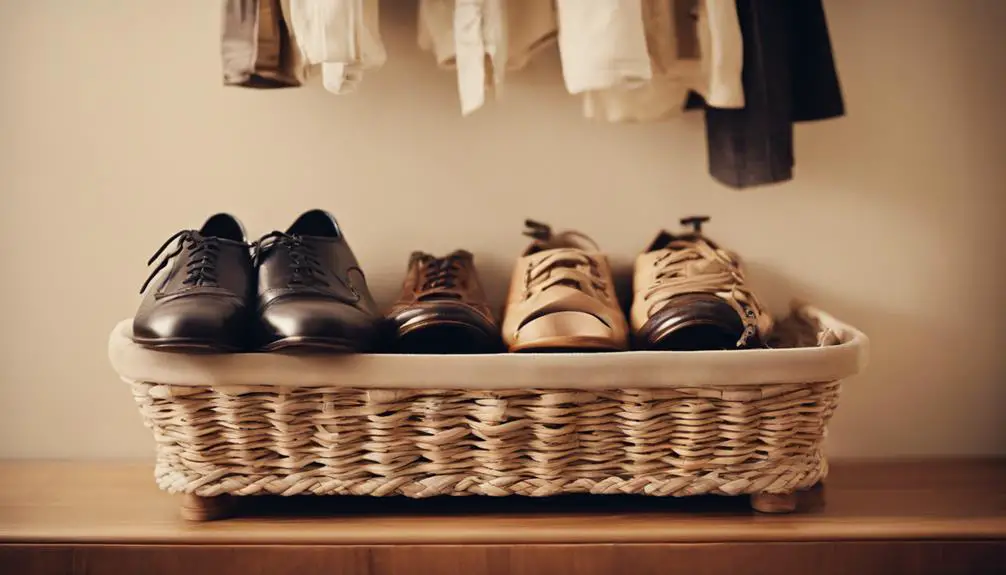
With your accessories neatly organized, it's time to turn your attention to creating a shoe station that keeps your footwear collection tidy and easily accessible.
A well-designed shoe station is essential for maintaining a clutter-free closet.
To get started, designate a specific area of your closet for your shoe station. You can use a shoe rack or install shoe cubbies to store your shoes.
Make sure the cubbies are spacious enough to accommodate your largest shoes. To prevent your heels from getting damaged, consider adding heel stops to each cubby. This will keep them upright and prevent them from toppling over.
You can also add a few baskets or bins to store shoe care products, such as polish, cleaner, and brushes.
Implement a One In, One Out Rule
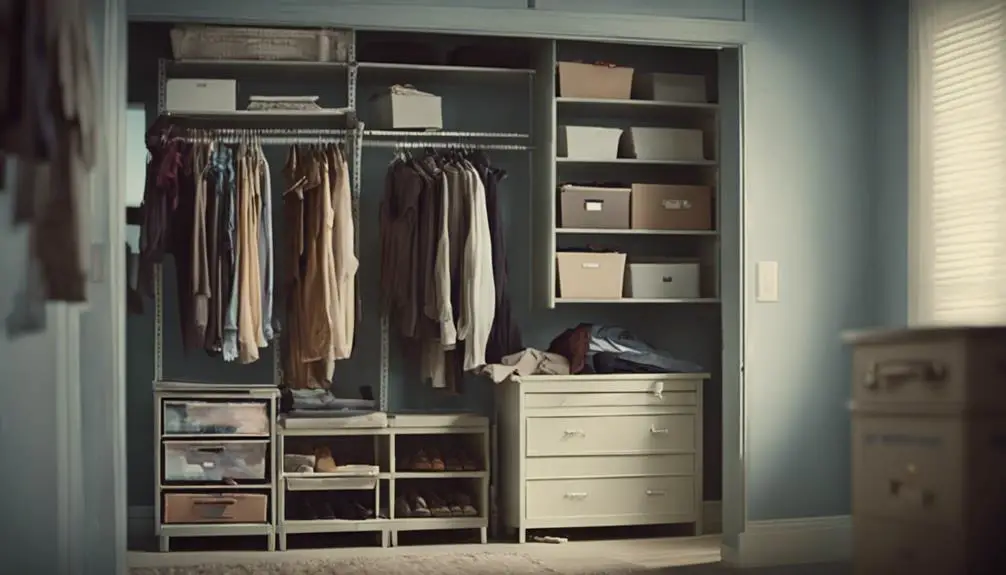
Every time you acquire a new piece of clothing, get rid of an old one to maintain a balanced and curated closet collection. This one-in-one-out rule guarantees your closet remains clutter-free and prevents unnecessary accumulation of clothes.
When you bring in something new, identify an old item that's no longer serving you and let it go. You can donate, recycle, or participate in a clothing swap to give your old clothes a new life.
Implementing this rule also encourages you to be more mindful of your purchasing habits. Before buying something new, ask yourself if it's worth replacing an existing item in your closet.
This thought process helps you prioritize your needs and make more intentional fashion choices.
Additionally, consider performing a seasonal purge to refresh your wardrobe and get rid of items that no longer fit or suit your style.
Make the Most of Corner Space
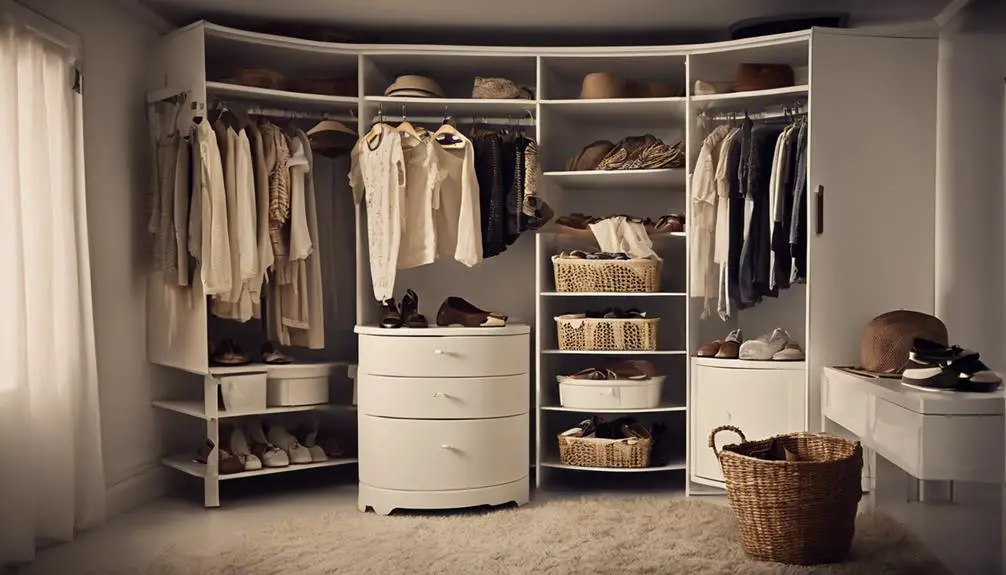
Optimizing the often-wasted corner space in your closet can substantially boost storage capacity and streamline your morning routine.
By utilizing innovative solutions, you can turn these neglected areas into valuable storage hubs. Consider installing corner carousels, which can be customized to fit your specific needs.
These rotating shelves allow you to access items easily, reducing clutter and making the most of the available space.
Alternatively, curved shelves can be a stylish and functional addition to your closet.
These shelves can be designed to fit snugly into corners, providing a seamless storage solution for folded items, bags, or accessories.
You can also install shelves with a lip to prevent items from falling off, ensuring your belongings remain organized and within reach.
By maximizing your corner space, you'll be able to store more items, reducing clutter and creating a sense of calm in your closet.
With a little creativity, you can transform these once-wasted areas into functional and stylish storage solutions that enhance your daily routine.
Use Baskets for Soft Items

Baskets can become your best friend when it comes to storing soft items, like sweaters, blankets, and linens, as they keep them clean, dust-free, and organized while adding a touch of warmth to your closet.
By using fabric bins, you can create a soft storage system that's both functional and visually appealing.
You can place them on shelves, in corners, or even on the floor, depending on the size and shape of your closet.
When choosing baskets, consider the type of items you'll be storing.
For example, if you have a lot of delicate or bulky items, look for baskets with sturdy handles and a soft, padded interior.
You can also label each basket so you can easily find what you need.
This system won't only keep your soft items organized but also make it easier to find what you're looking for.
Plus, the baskets will add a cozy touch to your closet, making it feel more like a relaxing retreat than a cluttered space.
Designate a Donation Station
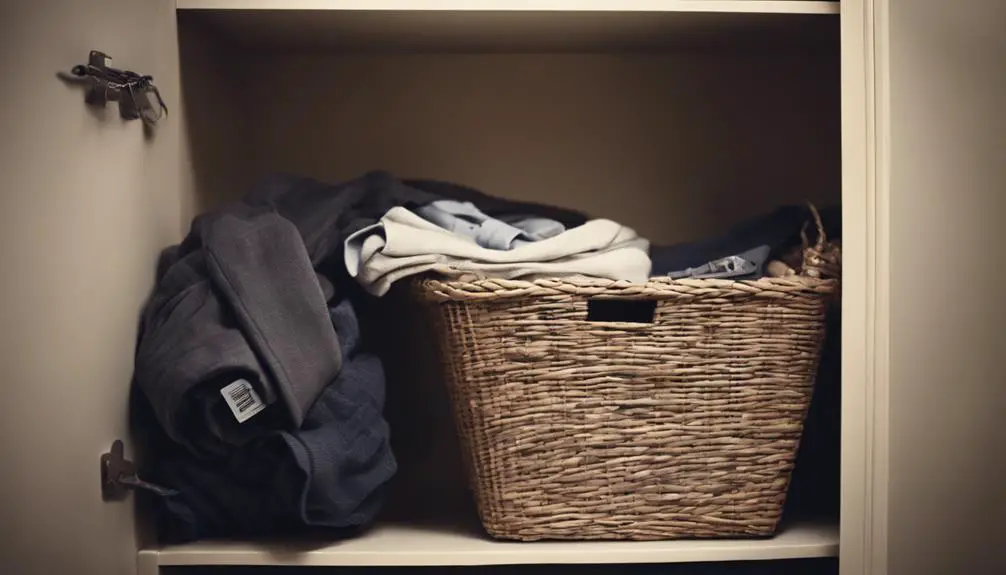
When organizing your closet, you'll inevitably come across items that are still in good condition but no longer serve you.
To keep your decluttering process on track, you'll need a designated spot to collect these items for donation.
Pick a Designated Spot
Designate a specific area in your home, like a corner of your bedroom or a section of your garage, to serve as a donation station where you can collect items you no longer need or want.
This designated spot will become a hub for your donation process, making it easier to gather and sort items as you go. When selecting a spot, consider creating a personalized zone that's easily accessible and convenient for your morning routine.
For instance, you can convert a section of your garage into a morning routine hub, where you can store donation bins and sort items as you get ready for the day.
Having a dedicated spot for donations will encourage you to regularly purge items that no longer serve a purpose.
You'll be more likely to drop off items as you go, rather than letting them pile up in your closet or around the house.
This habit won't only free up space in your closet but also help you develop a more mindful approach to consumption.
Set a Donation Goal
With your donation station set up, you're ready to set a goal for how often you'll donate and what you aim to achieve with your newfound habit of regularly purging items.
This goal will serve as your charity motivation, driving you to maintain a clutter-free closet and make a positive impact on your community.
Start by deciding on a realistic donation frequency, whether it's monthly, quarterly, or seasonal.
Next, determine what you want to achieve with each donation, such as filling a certain number of bags or reaching a specific weight in pounds.
Establishing specific goals will help you stay focused and motivated.
Consider setting donation deadlines to keep yourself on track and guarantee that your donations are made in a timely manner.
Label Everything for Clarity

Assigning a label to each shelf, bin, and hook helps to create a sense of order and makes it easy to locate specific items within your newly organized closet.
This simple step can make a huge difference in maintaining your closet's organization over time.
When it comes to labeling, having a clear and consistent labeling system is vital.
Invest in a label maker and use it to create labels that are easy to read and understand.
Use a font that's easy to read, keep labels concise, and use colors to categorize items.
For example, you can use red labels for winter clothing and blue labels for summer clothing.
Consider implementing a labeling system that categorizes items by type, season, or frequency of use.
Frequently Asked Questions
How Do I Keep My Closet Organized When I Have Limited Budget?
When you're on a tight budget, you can still achieve a clutter-free closet by repurposing items you already own, thrift shopping for affordable storage solutions, and getting creative with budget-friendly DIY organizers that won't break the bank.
Can I Use Closet Organizers With Non-Standard Closet Sizes?
When dealing with non-standard closet sizes, you can opt for custom fitted organizers designed specifically for your unique measurements, ensuring a seamless fit and maximizing storage capacity.
How Often Should I Clean and Maintain My Closet Organizers?
You should conduct a seasonal refresh every 3-4 months, doing a thorough closet audit to maintain your organizers, ensuring everything still fits, and removing items that no longer spark joy, keeping your space fresh and functional.
Are There Any Closet Organization Hacks for Small or Narrow Closets?
Since you're dealing with a small or narrow closet, you'll want to maximize space with narrow shelving and Double rods, allowing you to store more items without sacrificing accessibility or style.
Can I Customize My Closet Organizers to Fit My Personal Style?
You can absolutely tailor your closet organizers to reflect your unique taste by exploring custom design options, such as personalized shelving, that cater to your specific needs and style, ensuring a space that's truly one-of-a-kind.
Conclusion
You've now got the tools to transform your closet into a haven of organization and efficiency.
By maximizing vertical storage space, you'll be able to make the most of your closet's potential.
Doubling hang rods and utilizing hidden shelves will give you extra room to store your belongings.
Repurposing old furniture and investing in stackable containers will help keep your closet organized and clutter-free.
Making the most of corner space and using baskets for soft items will ensure that every inch of your closet is used efficiently.
Designating a donation station will encourage you to regularly purge items that no longer spark joy.
With these strategies in place, you'll be able to find what you need in an instant and enjoy a clutter-free closet that sparks joy.
